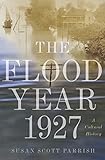The flood year 1927 : a cultural history / Susan Scott Parrish.
Material type: TextPublisher: Princeton : Princeton University Press, [2017]Description: xi, 396 pages : illustrations, maps ; 25 cmContent type: text Media type: unmediated Carrier type: volumeISBN: 9780691168838; 0691168830Subject(s): Floods -- Mississippi River Valley -- History -- 20th century | Disaster relief -- Mississippi River Valley -- History -- 20th century | Mississippi River Valley -- Social conditions -- 20th century | Mississippi River Valley -- History -- 1865- | Disaster relief | Floods | Social conditions | Mississippi River Valley | Since 1865Genre/Form: History.DDC classification: 977/.043 LOC classification: F354 | .P27 2017
TextPublisher: Princeton : Princeton University Press, [2017]Description: xi, 396 pages : illustrations, maps ; 25 cmContent type: text Media type: unmediated Carrier type: volumeISBN: 9780691168838; 0691168830Subject(s): Floods -- Mississippi River Valley -- History -- 20th century | Disaster relief -- Mississippi River Valley -- History -- 20th century | Mississippi River Valley -- Social conditions -- 20th century | Mississippi River Valley -- History -- 1865- | Disaster relief | Floods | Social conditions | Mississippi River Valley | Since 1865Genre/Form: History.DDC classification: 977/.043 LOC classification: F354 | .P27 2017| Item type | Current library | Call number | Copy number | Status | Notes | Date due | Barcode |
|---|---|---|---|---|---|---|---|
 Books
Books
|
Female Library | F354 .P27 2017 (Browse shelf (Opens below)) | 1 | Available | STACKS | 51952000236849 | |
 Books
Books
|
Main Library | F354 .P27 2017 (Browse shelf (Opens below)) | 1 | Available | STACKS | 51952000236832 |
Browsing Main Library shelves Close shelf browser

|

|

|

|

|

|

|
||
| F158.44 .V64 2013 Engineering Philadelphia : the Sellers family and the industrial metropolis / | F1788 .R58155 2016 Fighting over Fidel : the New York intellectuals and the Cuban Revolution / | F189.B19 .N475 2013 A new deal for all? : race and class struggles in Depression-era Baltimore / | F354 .P27 2017 The flood year 1927 : a cultural history / | F548.68.H9 .D38 2013 Chicago's historic Hyde Park / | F722 .B53 2012 Empire of shadows : the epic story of Yellowstone / | F805.M5 .M67 2011 Border dilemmas : racial and national uncertainties in New Mexico, 1848-1912 / |
Includes bibliographical references (pages 297-368) and index.
Introduction -- Modern overflow -- A Northern army of relief -- Cross talk in the press -- Bessie's eclogue -- Catastrophe comes to Vaudeville -- William Faulkner and the machine age watershed -- Richard Wright: environment, media, and race -- Conclusion: Noah's kin.
"The Great Mississippi Flood of 1927, which covered nearly thirty thousand square miles across seven states, was the most destructive river flood in U.S. history. Due to the speed of new media and the slow progress of the flood, this was the first environmental disaster to be experienced on a mass scale. As it moved from north to south down an environmentally and technologically altered valley, inundating plantations and displacing more than half a million people, the flood provoked an intense and lasting cultural response. The Flood Year 1927 draws from newspapers, radio broadcasts, political cartoons, vaudeville, blues songs, poetry, and fiction to show how this event took on public meanings. Americans at first seemed united in what Herbert Hoover called a "great relief machine," but deep rifts soon arose. Southerners, pointing to faulty federal levee design, decried the attack of Yankee water. The condition of African American evacuees in "concentration camps" prompted pundits like W.E.B. Du Bois and Ida B. Wells to warn of the return of slavery to Dixie. And environmentalists like Gifford Pinchot called the flood "the most colossal blunder in civilized history." Susan Scott Parrish examines how these and other key figures--from entertainers Will Rogers, Miller & Lyles, and Bessie Smith to authors Sterling Brown, William Faulkner, and Richard Wright--shaped public awareness and collective memory of the event. The crises of this period that usually dominate historical accounts are war and financial collapse, but The Flood Year 1927 enables us to assess how mediated environmental disasters became central to modern consciousness"--The publisher.
1 2

There are no comments on this title.